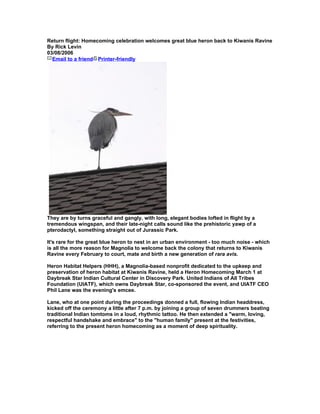
Return flight
- 1. Return flight: Homecoming celebration welcomes great blue heron back to Kiwanis Ravine By Rick Levin 03/08/2006 Email to a friend Printer-friendly They are by turns graceful and gangly, with long, elegant bodies lofted in flight by a tremendous wingspan, and their late-night calls sound like the prehistoric yawp of a pterodactyl, something straight out of Jurassic Park. It's rare for the great blue heron to nest in an urban environment - too much noise - which is all the more reason for Magnolia to welcome back the colony that returns to Kiwanis Ravine every February to court, mate and birth a new generation of rara avis. Heron Habitat Helpers (HHH), a Magnolia-based nonprofit dedicated to the upkeep and preservation of heron habitat at Kiwanis Ravine, held a Heron Homecoming March 1 at Daybreak Star Indian Cultural Center in Discovery Park. United Indians of All Tribes Foundation (UIATF), which owns Daybreak Star, co-sponsored the event, and UIATF CEO Phil Lane was the evening's emcee. Lane, who at one point during the proceedings donned a full, flowing Indian headdress, kicked off the ceremony a little after 7 p.m. by joining a group of seven drummers beating traditional Indian tomtoms in a loud, rhythmic tattoo. He then extended a "warm, loving, respectful handshake and embrace" to the "human family" present at the festivities, referring to the present heron homecoming as a moment of deep spirituality.
- 2. "This is a sacred time," Lane said. "A time of change. A time of transportation. Every single person in this circle, in this house, is wholly respected as a human being." Lane went on to acknowledge several member of the audience, including Magnolia Community Club past president Heidi Carpine, HHH newsletter editor Alice Marsh, UNAIT board chair Ed Claplanhoo and board secretary Marty Bluewater. He also introduced John Halliday, a member of the Muckleshoot tribe in Yakima who told a humorous story about how the great blue heron got yellow eyes. (In the legend related by Bluewater, the bird replaces his lost eyes with chokecherries, which cast a beautiful tint on everything he sees.) Lane, with a combination of disarming humor and earnestness, addressed in his talk the fractious nature of modern life, making a passionate plea for connectedness in preserving not just the heron's way of life but that of the wider Advertisement world. "What we need at this time is unity," he said. "We kind of went haywire this last few hundred years. We can correct that. "We want with all our heart and soul," he added, "to see this land restored the way it was 200 years ago." Robin Clark, from the nonprofit conservation group People for Puget Sound, spoke to the crowd about the oddly gorgeous appeal of the great blue heron. "They bring you back to that prehistoric time," she said, adding that the best way for folks to honor the bird is to "pay attention" to their way of life. "That's the most important thing in the world," she said: "To pay attention. With our climate changing, sometimes watching the critters is the most important thing you can do." Clark also said that Magnolia residents should consider themselves blessed to have a heron colony in their midst. "In other places, they [heron] stay away from human disturbance. Heron are typically shy." There are two things that can cause a heron colony to abandon its nest, Clark explained, the first being the aforementioned human disturbance. The other thing is unexpected noise, she said, whether that be the toot of a car horn or the crash of a bulldozer paving the way for construction. For this reason, "restoration is really important," Clark said. "They have to have food really close by," and too much urban development too close to the nest may cause them to
- 3. move on to a quieter, more remote habitat. The two-hour event closed with a call to join the heron group by member Rich Lassman, and a presentation on the birds' nesting activities given by Pam Cahn, who screened a short video of the herons shot at Kiwanis Ravine. Several groups set up booths on the main floor of Daybreak Star, where attendees mingled, talking and eating complimentary cake and fruit, for the hour prior to the presentation. Among those organizations setting up displays were the Seattle Urban Nature Project, PlantAmnesty, People for Puget Sound, Seattle Works, Seattle Audubon and the Discovery Park Advisory Council. Also, UIATF presented a schematic for work on the site of Daybreak Star Indian Cultural Center. For further information, call 284-6489, visit www.heronhelpers.org or send an email inquiry to info@heronhelpers.org. flight ©Pacific Publishing Company 2006 WWW.FWII.NET
